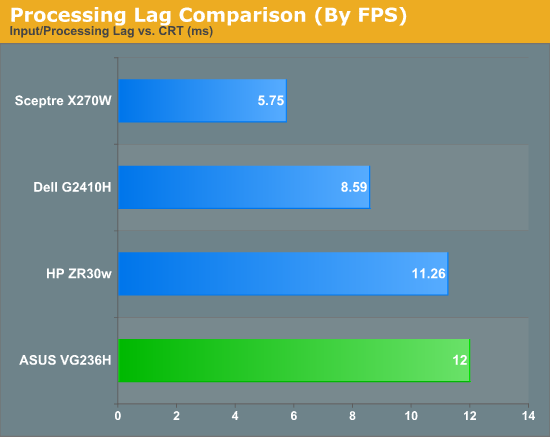ASUS VG236H 23-inch 3D Display Review: 120Hz is the Future
by Brian Klug on August 7, 2010 2:48 AM ESTProcessing and Input Latency
Processing and display lag is a very important thing for gamers, and it’s most often nebulously reported if at all. We’ve discussed this in previous display reviews, but what matters most is how the display acts in real world testing. I’ve been doing previous tests by comparing LCDs with first a 17” Princeton CRT, then a Sony G520 20” CRT.
So far the results have been a bit interesting, with the CRT barely edging out over the LCD. I did the same thing with the VG236H.
Jarred and Anand both warned me right after my first attempt with this method that we were probably going to see a difference purely because we’re comparing an analog VGA signal for the CRT to the DVI signal for the LCD in test. The problem being that because of the way we test, it’s likely the VGA and DVI paths get different frames from the framebuffer entirely. In addition, because I had the Zotac GTX 470 instead of the ATI Radeon HD5870 like previous tests, there’s another element of change here.
I ran through the tests as usual and measured the difference between the CRT at 75Hz (its maximum, seriously), and the VG236H at 120Hz running the 3Dmark Wings of Fury benchmark on constant loop. The ASUS comes in about 12ms behind the CRT after collecting 14 different samples.

I used the VG236H to play a number of FPS games during my time with it, and never noticed perceptible input lag. I’m convinced there’s something else at play here.
Remember how I mentioned the display has overdrive, er... “trace free” controls? By default, outside of 3D mode, trace free is set to 60. I decided to test at 100 and 0, effectively with overdrive on maximum, and off entirely. Turning overdrive off adds a repeatable 2.2ms of display latency after 20 data points.
More importantly, it effectively reduces the number of ghost images captured from two (one trailing, one preceding), to one (just trailing). Now you can understand why ASUS probably sets overdrive to maximum in 3D mode and keeps you from touching it, to virtually guarantee no ghosting or weird artifacts.
While we’re on that subject, I’ll note that I only noticed ghosting once while playing Metro 2033 start to finish in 3D with the VG236H, and even then I first thought it was something reflecting weird in the glasses. I’ve read about other displays having very obvious ghosting - you’d be hard pressed to find that with the VG236H.
I wasn’t entirely convinced that the VG236H had more input lag than any display I had tested previously, so I decided to test against a display I’m pretty fond of - my BenQ FP241W. Now, what about how the VG236 compares to it?
The VG236H consistently lags 1 frame from the FP241W, regardless of FPS, across about 40 photos I captured of the two displays. It’s always exactly one frame behind.
So what does that mean? Well, we’re likely seeing the difference between the 60Hz refresh rate of the FP241W and the 120Hz refresh rate of the VG236H. The higher refresh rate lets the ASUS show more frames than the FP241W, giving us more granularity. It just so happens that it’s pulling one frame behind, which on average worked out to a lag of 1.9 ms.
Further, Jarred tested the FP241VW which is essentially the exact same monitor as the FP241W but in a different enclosure, and measured input processing lag to be 2 ms compared to the famous HP LP3065 (which has no scaler and no input lag). Thus, a more accurate number for input lag on the ASUS VG236H is the sum of the two, at a much more respectable 3.9ms.













121 Comments
View All Comments
Gris - Monday, August 9, 2010 - link
"Manufacturers need to create circularly polarized monitors before it is really usable."I think you may be right, (if that's even viable), but more so for tv's than computer monitors where viewing in a vertical position is more the norm.
zoxo - Monday, August 9, 2010 - link
Yes indeed, but why settle for a half-solution?But I agree, that anything that uses passive glasses is a huge step-up. Those active glasses drive me nuts.
ChongDOTcom - Monday, August 9, 2010 - link
I guess this display is quite popular, since it's sold out at nearly every online retailer. The only site I could find that has some in stock was Best Buy, where I luckily just ordered one last night.I was originally going to get the Alienware Optx, but that's the same price but doesn't come with the glasses. It looks a little cooler, but they seem extremely similar. I don't even need the glasses, though (I have an ATI card). I'll likely sell them.
Anybody know any workarounds to get 3D to work on this screen? I'd be willing to purchase another 3D kit.
meldog11 - Tuesday, August 10, 2010 - link
i think most of you are missing the point...the point is true functioning 3-d gaming on almost 24 inches of landscape @ true 1080p.....i hear you throwing out a huge wish list of things that arent available now nor where they available before....but this is closer to your wish list of demands, at a price point that 3 months ago you could only get 22 inches and 1680 x 1050.....what i took from this whole review is that the reviewer was overwhelmingly impressed with the 3d technology...meaning it actually "works" and a worthy skeptic is converted!...so if your not a fan of 3d technology then fine, if you wont be impressed with a new level of immersion in the games that you play fine, if close to 24 inches of landscape dont improve on the previous 22 inches of landscape fine.....but make no mistake about it this is a definite step in the right direction in terms of gameplay and performance for an imerging tech and at a price point that is impressive or at least competative to its predeccesors......just my humble opinionRaZz! - Thursday, August 12, 2010 - link
Nice review. In the conclusion you mention the Acer and Alienware monitors - in my opinion the LG W2363D should be named in this league as well.Since reviews of these monitors are cluttered all over the web on different sites with different test methods etc, it's pretty hard to really compare the monitors respectively the results from these tests.
I'd really love to see these 120Hz monitors tested with the same test methods - compared from one source.
Anandtech would do a lot of people a favor with a 120Hz monitor roundup ;) Many forums have threads going on with exact this topic and a lot of people are unsure which monitor is better. Facts and detailed field reports are very rare, even though some of these monitors are out there for quite some time already.
On a side note: there have been a lot of issues reported for the Acer, like too aggressive Overdrive which makes fonts too sharp and hardly readable as well as green and red coronas when doing fast turns in games. Videos of these problems can be found on Youtube for example.
Sabresiberian - Thursday, August 12, 2010 - link
I'm sooo glad to read an up-to-date article that describes the 120Hz LCD monitor in a discreet state. The previous articles I read (back when they first came out ) left me with the impression that they weren't really 120 Hz, just 60Hz gimmicked-up, and not much better. Brian has answered that question and I am thrilled to know we aren't entirely hampered with 60Hz as a standard for future video.Looking forward to a real quality unit along the lines of the Dell U2711 or HP ZR30w in true 120 Hz capability. Better yet, true 240 Hz so that each eye can live with 120 Hz in a 3D setup! Heh.
Orip - Saturday, August 14, 2010 - link
Seems to be doing whatever the Asus VG236H is doing (except that the 2233RZ is 22" but is also a 16:10).What am I missing?
Orip - Saturday, August 14, 2010 - link
Being keen on the sanctity of my fps I'm still using my good ole' trusted Iiyama CRT.Now that LCDs are nailing down 120mhz I could finally grab one but there seem to be no concensus as to where one's money would be best spent.
The samsung is cheaper by far out of all the 120mhz LCDs out there (atleast in israel that's the case).
A lil' help here would be welcome :)
Thanks! :)
fingerbob69 - Tuesday, August 17, 2010 - link
As the subject line says 120hz ips panels are the way to go; colour reprodution and fluidity of movement... with no issue regarding viewing angles.I have one of those NEC ea231wmi panels and I have to say it's fantastic. I play a lot of fps games and have not noticed any colour distortion, left to right, ghosting or lag and I've had no problem with the anti glare coating. Maybe I'm just too easily pleased!
DarkUltra - Thursday, August 19, 2010 - link
I don't see any black level impressions. Just that contrast is good and MEtro 2033 needs a bump in the gamma setting in 3D mode. Other reviews have found the black level on this monitor bad:The display was equally unable to separate very dark grays from absolute black. As a result, we had a difficult time seeing what was happening in the Blu-ray version of Watchmen’s opening fight sequence.
http://www.maximumpc.com/article/reviews/asus_vg23...
This is not acceptable to me. I don't wanto mess with gamma settings in games and reduce the color representation further. I guess I'll get the LG W2363D or wait for a 16:10 or LED backlit 120hz monitor.
The other 120hz monitors have other issues, AW2310 have blurring and smearing in 2d mode despite the 120hz performance, GD245HQ have serious sharpness issues, the others are "only" 22" panels.